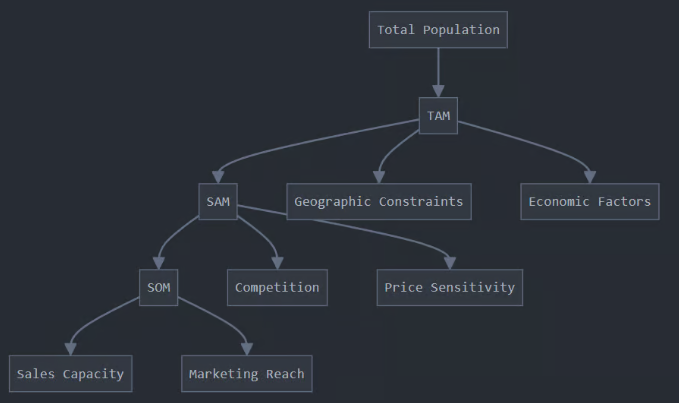Integrating AI into Market Research: TAM/SAM/SOM Systems
In today's rapidly evolving business landscape, market size analysis remains a cornerstone of strategic planning. The traditional TAM/SAM/SOM framework (Total Addressable Market, Serviceable Addressable Market, and Serviceable Obtainable Market) has long guided businesses in understanding their market potential. However, the emergence of generative AI and multi-agent systems is revolutionizing how we approach this crucial analysis. This article explores how AI can enhance traditional market research methods while increasing both speed and accuracy.
Currently, most companies do a decent job of estimating TAM using a series of industry reports that all gravitate towards similar growth rates. However, the SAM subset is often a wild guess based on some simple regional or demographic split. Similarly, the SOM subset is another wild guess in the 3% to 10% share range, maybe using some similar company that was able to get that much. Using Gen AI and vector stores, we can get much more systematic about which factors are reducing the SAM and SOM at each stage.
The Evolution of Top-Down Market Research: Data-Driven Precision
Traditional top-down market analysis has been revolutionized by the integration of AI with historical market databases and vector stores. This combination enables analysts to make more nuanced predictions based on analogous market developments across different sectors and time periods.
Database Integration for Enhanced Analysis
Modern AI systems can simultaneously access and analyze:
- Industry-specific market research databases (e.g., Frost & Sullivan, IBISWorld)
- Historical company performance data
- Patent databases for innovation tracking
- Regulatory filing databases
- Social media sentiment data
By vectorizing this data, AI can identify patterns in market evolution across seemingly different sectors. For example, when analyzing a new healthcare technology market, the AI might identify similarities with:
- The evolution of mobile payment adoption in fintech
- Enterprise SaaS penetration rates in different verticals
- Consumer adoption curves for digital health platforms
Pattern Recognition in Market Share Development
AI systems can now analyze historical patterns of market share development across different company types:
-
Category Creators (High Share Potential):
- ZocDoc's development in healthcare booking (achieved 40% market share in key metros)
- Airbnb's creation of the mainstream home-sharing market (>19% of lodging in major markets)
- Uber's dominance in ride-hailing (>65% in many markets)
-
Large Market Disruptors (Moderate Share):
- Red Bull's growth in the massive beverage market (0.5% of total beverages, but 46% of energy drinks)
- Beyond Meat's penetration of the protein market (1.4% of total protein, but 35% of plant-based)
The AI can adjust TAM projections based on these patterns, considering:
- Market maturity stage
- Regulatory environment
- Technology adoption curves
- Competition dynamics
Vector Store Implementation
Modern implementations utilize vector stores to create sophisticated market analysis systems that can quickly retrieve and analyze relevant market patterns and growth trajectories. These systems connect to visualization tools like LucidChart for dynamic market mapping.

Bottom-Up Analysis: Granular Insights Through AI
The bottom-up approach benefits significantly from AI's ability to process granular data points and identify subtle patterns in customer behavior and market development.
Customer Segmentation Enhancement
AI systems can now integrate multiple data sources for precise customer segmentation.
-
Demographic Data:
- Census databases
- Consumer behavior databases
- Social media activity patterns
- Professional network data
-
Purchasing Power Analysis:
- Regional economic indicators
- Industry-specific spending patterns
- Technology adoption rates
- Disposable income trends
Let's visualize this segmentation approach:

Market Share Projection Using Historical Patterns
AI can analyze successful companies' growth trajectories to project realistic market share development:
-
High-Growth Scenarios:
- Analysis of unicorn growth trajectories
- Market creation patterns
- Network effect acceleration curves
-
Moderate Growth Patterns:
- Traditional market entry curves
- Competitive response patterns
- Resource constraint impacts
Market Expansion Analysis
AI excels at identifying and analyzing expansion opportunities through pattern recognition and predictive analytics. A multi-agent system can simultaneously evaluate:
- Geographic expansion potential
- Product line extensions
- Market segment opportunities
- Pricing tier possibilities
AI agents can be configured to continuously monitor:
- Market entry barriers
- Regional growth rates
- Cultural adaptation requirements
- Competitive dynamics
By connecting these analyses to visualization tools like Miro, businesses can create dynamic expansion roadmaps that update automatically as market conditions change.
Valuation Integration
The final step in market sizing often involves translating market share projections into company valuations. AI can enhance this process by:
- Automatically updating revenue multiples based on market conditions
- Generating scenario-based valuations
- Integrating market sentiment analysis
- Creating dynamic valuation models
Consider this SOM valuation sample calculation flow:
Building an Integrated AI Workflow
To implement these AI-enhanced processes, organizations can create a comprehensive multi-agent workflow using platforms like Microsoft Copilot Studio or custom GPTs. Here's a recommended architecture:
-
Data Collection Agents:
- Monitor market research databases
- Scrape relevant news and updates
- Process competitor information
-
Analysis Agents:
- Normalize and clean data
- Perform statistical analysis
- Generate forecasts
-
Visualization Agents:
- Create standardized charts
- Generate presentation-ready graphics
- Update dashboards
-
Integration Agents:
- Connect with external tools
- Maintain database consistency
- Generate automated reports

Looking Forward
The integration of AI into market sizing analysis represents a significant leap forward in both accuracy and efficiency. By combining traditional methodologies with AI-powered tools, organizations can:
- Process more data sources
- Generate more accurate projections
- Identify opportunities faster
- Create more dynamic visualizations
- Update analyses in real-time
The future of market sizing will likely see even greater integration of AI tools, with increasingly sophisticated multi-agent systems handling complex analyses automatically. Organizations that embrace these technologies today will be better positioned to make data-driven decisions tomorrow.
Remember that while AI significantly enhances the market-sizing process, human oversight remains crucial for strategic interpretation and decision-making. The most successful implementations will balance AI capabilities with human expertise to create comprehensive, accurate, and actionable market analyses.
This integrated approach to market sizing, combining AI-powered analysis with traditional methodologies, represents the future of strategic market planning. By leveraging these tools effectively, businesses can make more informed decisions about market entry, expansion, and resource allocation.





